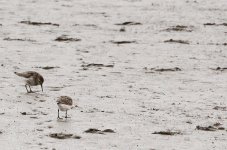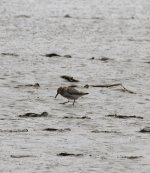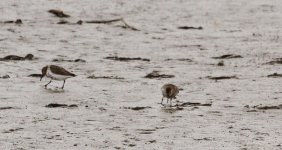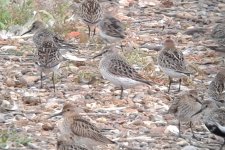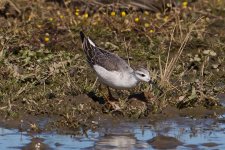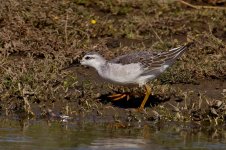-
Welcome to BirdForum, the internet's largest birding community with thousands of members from all over the world. The forums are dedicated to wild birds, birding, binoculars and equipment and all that goes with it.
Please register for an account to take part in the discussions in the forum, post your pictures in the gallery and more.
You are using an out of date browser. It may not display this or other websites correctly.
You should upgrade or use an alternative browser.
You should upgrade or use an alternative browser.
Norfolk birding (8 Viewers)
- Thread starter Edward woodwood
- Start date
More options
Who Replied?john miller
Well-known member
Anyone managed to get a photo of this bird at Cley yet?
Best one so far is by Nik Borrow showing on Surfbirds
John
Mark Batten
Well-known member
A few more pics..
Why it not a Dunlin?
lostinjapan
Well-known member
Hi Mark
Not saying it isn't a Dunlin. It just seemed to have a much more striking super behind te eye and a shorter bill, as well as being shorter. The head was strikingly rufous and it appeared to have a little rufous area on the cheeks. The flank streaking appeared to be thinner and heavier to me than other Dunlin present.
It seemed to appear quite bull-necked, and almost crouched and a little top-heavy. At times it appeared to have longer primary projection, but not sure if that was simply the angle of viewing.
I guess it could simply be a smaller race Dunlin and as I said I realise now not a White-rumped Sandpiper.
It was cold up on the bank, and maybe all the other good birds made me make more out of this bird than I should have done!!
I did put it out as a possible, and showed photos at the centre, though they were none the wiser.
You live and learn .
.
Good birding
Sean
Not saying it isn't a Dunlin. It just seemed to have a much more striking super behind te eye and a shorter bill, as well as being shorter. The head was strikingly rufous and it appeared to have a little rufous area on the cheeks. The flank streaking appeared to be thinner and heavier to me than other Dunlin present.
It seemed to appear quite bull-necked, and almost crouched and a little top-heavy. At times it appeared to have longer primary projection, but not sure if that was simply the angle of viewing.
I guess it could simply be a smaller race Dunlin and as I said I realise now not a White-rumped Sandpiper.
It was cold up on the bank, and maybe all the other good birds made me make more out of this bird than I should have done!!
I did put it out as a possible, and showed photos at the centre, though they were none the wiser.
You live and learn
Good birding
Sean
Nick Moran
Well-known member
Hi Sean
Definitely a (smallish) Dunlin. As the attached (rubbish) image of the White-rumped Sandpiper that was at Snettisham 22/8/13 shows, the underpart streaks on that species 'hug' the line of the wings, and continue all the way to the sides of the vent (albeit sparsely), whilst the central belly is clean white.
In contrast, the streaks on Dunlin come away from the line of the wing, creating the impression of a clean white 'wedge' that broadens from the 'shoulder' of the closed wing towards the tail. The area of streaking on (juv) Dunlin at this time of year matches the area that will be black in breeding plumage. In my experience, very few Dunlin show streaking on the vent-sides.
There are various other features but I think the black belly-streaking of Dunlin is unique amongst the Calidrids that have been recorded in Britain.
Cheers
Definitely a (smallish) Dunlin. As the attached (rubbish) image of the White-rumped Sandpiper that was at Snettisham 22/8/13 shows, the underpart streaks on that species 'hug' the line of the wings, and continue all the way to the sides of the vent (albeit sparsely), whilst the central belly is clean white.
In contrast, the streaks on Dunlin come away from the line of the wing, creating the impression of a clean white 'wedge' that broadens from the 'shoulder' of the closed wing towards the tail. The area of streaking on (juv) Dunlin at this time of year matches the area that will be black in breeding plumage. In my experience, very few Dunlin show streaking on the vent-sides.
There are various other features but I think the black belly-streaking of Dunlin is unique amongst the Calidrids that have been recorded in Britain.
Cheers
Attachments
Last edited:
Mark Batten
Well-known member
Hi Sean. I was only my first thoughts on seing your photos was that it was a Dunlin. Dunlin and Sanderling get mistaken for all things rare! You are also in good company as all of us have fallen into the "rare" trap at some point. Enjoy your birding and remember common waders (particularly Dunlin) come in all all shapes and sizes. Paul who works at RSPB Titchwell would have been able to ID your bird from your photo's. Kind Regards. Mark.
Last edited:
john miller
Well-known member
Paul who works at RSPB Titchwell would have been able to ID your bird from your photo's. Kind Regards. Mark.
Sadly I was in a meeting in King's Lynn when Sean came in with the photos. Does look like a juv dunlin to me though, variable little devils!
Paul
PYRTLE
Old Berkshire Boy

Not a whiff
Tremendous photo Mr Miller - still marooned down in West Sussex.... oh to be back in Norfolk!
Pat
Wilsons showing better this morning in the sunlight.
John
wwwkellingnature.zenfolio.com
Tremendous photo Mr Miller - still marooned down in West Sussex.... oh to be back in Norfolk!
Pat
Titchwell September 18th
Today's highlights
Pectoral sandpiper - 2 juvs on fresh marsh all day although elusive at times
Spoonbill - 2 on fresh marsh
Long tailed duck - 2 offshore
Little stint - 2 on fresh marsh
Pink footed goose - 200+ in small flocks in/off sea this afternoon
Paul
Today's highlights
Pectoral sandpiper - 2 juvs on fresh marsh all day although elusive at times
Spoonbill - 2 on fresh marsh
Long tailed duck - 2 offshore
Little stint - 2 on fresh marsh
Pink footed goose - 200+ in small flocks in/off sea this afternoon
Paul
Mark Batten
Well-known member
Sadly I was in a meeting in King's Lynn when Sean came in with the photos. Does look like a juv dunlin to me though, variable little devils!
Paul
Can not see much that is variable from the photos. Bird could have looked different in the field?
lostinjapan
Well-known member
Thanks
Hi Nick
I've seen White-rumped Sandpiper before, and indeed refound the bird on Layer Breton causeway a couple of years back, but have not had many chances to see them abroad, as I've mainly birded Asia and Australia.
Anyway the white wedge was something I could see in the photos afterwards, but not in the field, as the birds were constantly moving.
I thought the extent of the black streaking on the flanks also wasn't right,
but I guess I was just fooled by its seemingly smaller size and more hunched demeanour.
I'm usually a bit more cautious about putting news out until I'm absolutely certain. Hence I went into the centre I wanted to have someone to give a second opinion/reality check . Ashame Paul wasn't there, but they were still very helpful in the centre. In hindsight I probably should've waited until I'd had a chance to go back over my notes and images before putting any sort of news out.
. Ashame Paul wasn't there, but they were still very helpful in the centre. In hindsight I probably should've waited until I'd had a chance to go back over my notes and images before putting any sort of news out.
Second time I've made a faux-pas this autumn, so will keep my head down & keep improving my clearly rusty ID skils..too much time spent abroad looking at seabirds clearly!!
Thanks for the responses by Paul, Mark & Nick .
Hope to find something good for all you Norfolkite birders soon.
Good birding
Sean
Hi Sean
Definitely a (smallish) Dunlin. As the attached (rubbish) image of the White-rumped Sandpiper that was at Snettisham 22/8/13 shows, the underpart streaks on that species 'hug' the line of the wings, and continue all the way to the sides of the vent (albeit sparsely), whilst the central belly is clean white.
In contrast, the streaks on Dunlin come away from the line of the wing, creating the impression of a clean white 'wedge' that broadens from the 'shoulder' of the closed wing towards the tail. The area of streaking on (juv) Dunlin at this time of year matches the area that will be black in breeding plumage. In my experience, very few Dunlin show streaking on the vent-sides.
Cheers
Hi Nick
I've seen White-rumped Sandpiper before, and indeed refound the bird on Layer Breton causeway a couple of years back, but have not had many chances to see them abroad, as I've mainly birded Asia and Australia.
Anyway the white wedge was something I could see in the photos afterwards, but not in the field, as the birds were constantly moving.
I thought the extent of the black streaking on the flanks also wasn't right,
but I guess I was just fooled by its seemingly smaller size and more hunched demeanour.
I'm usually a bit more cautious about putting news out until I'm absolutely certain. Hence I went into the centre I wanted to have someone to give a second opinion/reality check
Second time I've made a faux-pas this autumn, so will keep my head down & keep improving my clearly rusty ID skils..too much time spent abroad looking at seabirds clearly!!
Thanks for the responses by Paul, Mark & Nick .
Hope to find something good for all you Norfolkite birders soon.
Good birding
Sean
Robert S J Smith
Well-known member
Has the possible Italian Sparrow been seen of late? Not seen a report of it for a while.
Hi Nick
I've seen White-rumped Sandpiper before, and indeed refound the bird on Layer Breton causeway a couple of years back, but have not had many chances to see them abroad, as I've mainly birded Asia and Australia.
Anyway the white wedge was something I could see in the photos afterwards, but not in the field, as the birds were constantly moving.
I thought the extent of the black streaking on the flanks also wasn't right,
but I guess I was just fooled by its seemingly smaller size and more hunched demeanour.
I'm usually a bit more cautious about putting news out until I'm absolutely certain. Hence I went into the centre I wanted to have someone to give a second opinion/reality check. Ashame Paul wasn't there, but they were still very helpful in the centre. In hindsight I probably should've waited until I'd had a chance to go back over my notes and images before putting any sort of news out.
Second time I've made a faux-pas this autumn, so will keep my head down & keep improving my clearly rusty ID skils..too much time spent abroad looking at seabirds clearly!!
Thanks for the responses by Paul, Mark & Nick .
Hope to find something good for all you Norfolkite birders soon.
Good birding
Sean
Hi Sean
At least you came in and told someone, most people would normally write that in the book, not tell anyone and leave!
I had a pleasant evening looking for it anyway
Paul
Nick Moran
Well-known member
Hi Nick
I've seen White-rumped Sandpiper before, and indeed refound the bird on Layer Breton causeway a couple of years back, but have not had many chances to see them abroad, as I've mainly birded Asia and Australia.
Anyway the white wedge was something I could see in the photos afterwards, but not in the field, as the birds were constantly moving.
I thought the extent of the black streaking on the flanks also wasn't right,
but I guess I was just fooled by its seemingly smaller size and more hunched demeanour.
I'm usually a bit more cautious about putting news out until I'm absolutely certain. Hence I went into the centre I wanted to have someone to give a second opinion/reality check. Ashame Paul wasn't there, but they were still very helpful in the centre. In hindsight I probably should've waited until I'd had a chance to go back over my notes and images before putting any sort of news out.
Second time I've made a faux-pas this autumn, so will keep my head down & keep improving my clearly rusty ID skils..too much time spent abroad looking at seabirds clearly!!
Thanks for the responses by Paul, Mark & Nick .
Hope to find something good for all you Norfolkite birders soon.
Good birding
Sean
No probs at all – as Paul says, better to tell some one and get a second opinion (though it seems relatively few folk are prepared to follow up possible/probable reports on the news services).
I started to entertain ideas of a Yank whilst watching a small Calidrid through my '2nd' (ie naff) scope a few summers ago. Called in a mate with a Swaro and guess what? Juv Dunlin! Fortunately he'd been painting the living room and was only too happy for an excuse to get out!
Last edited:
VillagerFred
Well-known member
There are examples of both alpina and small number of schinzii sub-species of Dunlin around at the moment, and the schinzii are notably a size smaller in the hand. The main bulk of them use the East coast as a stop over point after breeding and continue their migration on to Africa.
Paul Woolnough
Well-known member
Agree that bird was a dunlin. Race in-determined.
Watchers should not be afraid to put news out (or post photographs) of unidentified birds they have found.
Too large for least sandpiper (dream on!). Semi-palmated sandpiper was a possibility but photos show birds feet fit dunlin as ID, never mind other features on the bird which can be studied at leisure on our computers.
(Lesser grey shrike near Sizewell found by non-twitchers who were unsure of its ID.)
Watchers should not be afraid to put news out (or post photographs) of unidentified birds they have found.
Too large for least sandpiper (dream on!). Semi-palmated sandpiper was a possibility but photos show birds feet fit dunlin as ID, never mind other features on the bird which can be studied at leisure on our computers.
(Lesser grey shrike near Sizewell found by non-twitchers who were unsure of its ID.)
Mark Batten
Well-known member
Are the 2BX's showing at all times of the day? Is there a best time of the day to connect?
Users who are viewing this thread
Total: 9 (members: 0, guests: 9)




